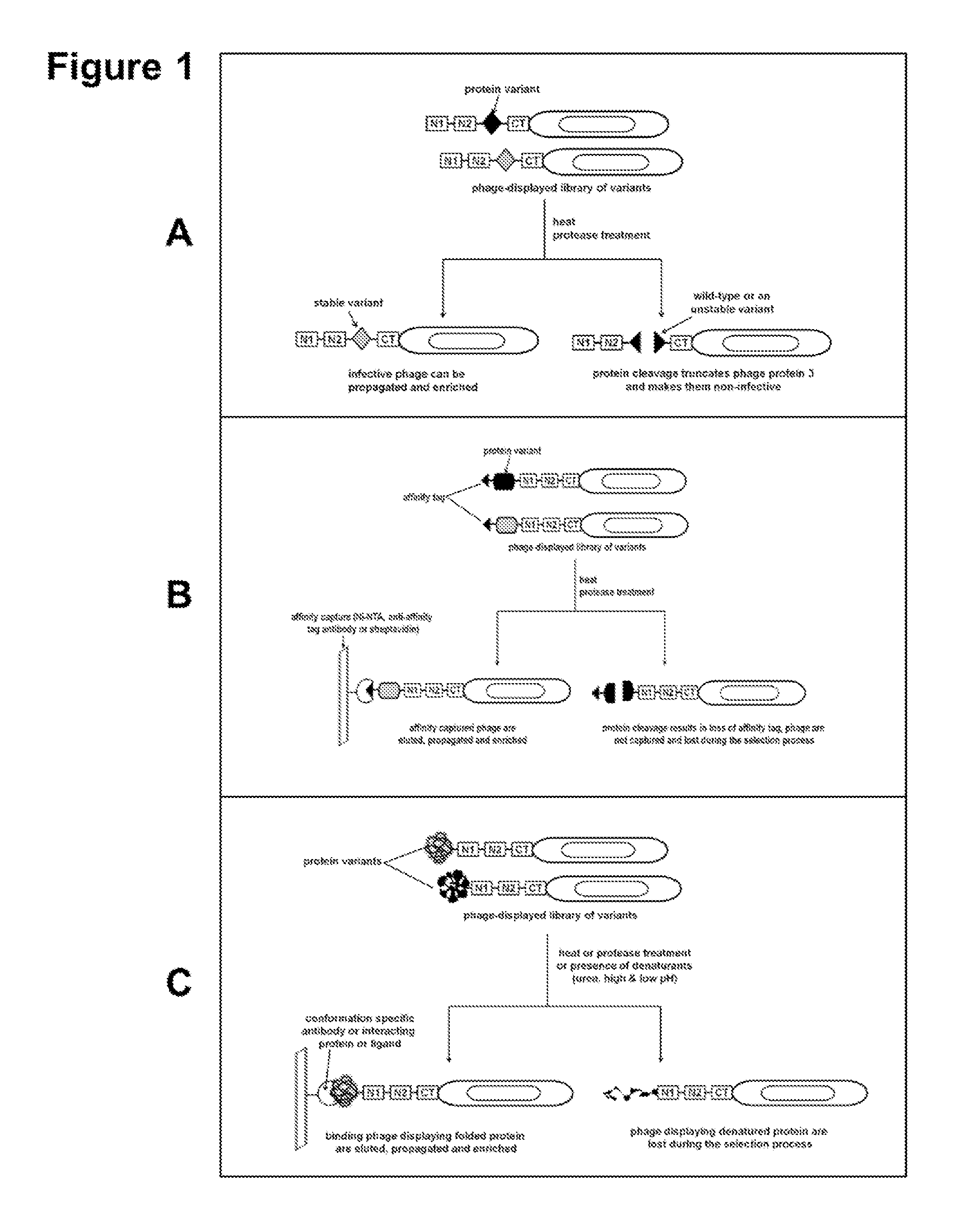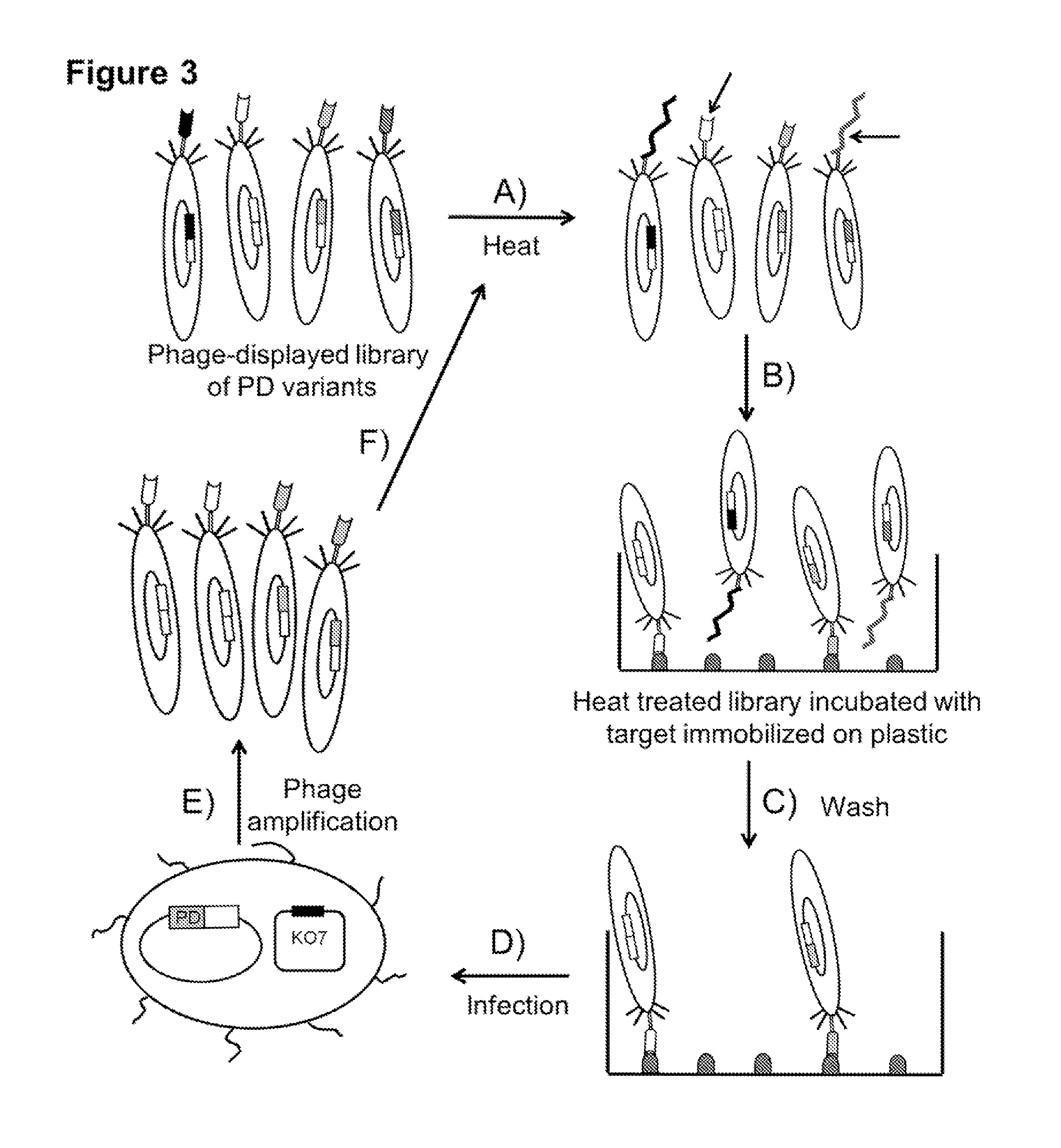Compositions comprising engineered phosphothreonine affinity reagents, methods of making, and methods of use
a technology of affinity reagents and phosphothreonine, which is applied in the field of protein scaffolds, can solve the problems of time-consuming, laborious, and impractical processing, and achieve the effects of reducing the cost of production, improving the efficiency of production, and improving the quality of production
- Summary
- Abstract
- Description
- Claims
- Application Information
AI Technical Summary
Benefits of technology
Problems solved by technology
Method used
Image
Examples
example 1
Gene Synthesis and Subcloning into Phage and Expression Vectors
[0047]A variant of the FHA1 domain from the S. cerevisiae Rad53 protein, named the 3C-3S variant, which has three cysteine residues mutated to serine (C34S, C38S, and C154S), was commercially synthesized (Blue Heron Biotechnology) with codons optimized for expression in E. coli and the DNA was provided after subcloning into the Blue Heron pUC plasmid (derivative of pUC119). The 3C-3S coding sequence was amplified by polymerase chain reaction (PCR), using primers FHA1-Ncol-Fw and FHA1-Notl-Rv and the AccuPrime™ Pfx DNA polymerase (Invitrogen), for creating flanking Ncol / Notl restriction enzyme sites for subcloning into the phagemid vector (pKP600) in-frame with the gene III coding sequence. The phagemid vector (Pershad et al. (2011) Anal Biochem 412, 210-6) used is a modified version of the pKP300 vector except that it has a DsbA signal sequence and lacks the alkaline phosphatase coding sequence. All of the primers were o...
example 2
Construction of Phage-Displayed Libraries
[0049]To generate a library of FHA1 variants, from which functional phage-displayed variants can be isolated by affinity selection, mutagenic PCR (Cadwell et al. (1994) PCR Methods Appl 3, S136-40) was performed (primers: MP-FHA1-Fw and MP-FHA1-Rv), using the coding sequence of the 3C-3S variant as the starting template. One cysteine remained, which was away from the binding surface, so that it could be derivatized through maleimide coupling chemistry for future immobilization to resin. Mutagenic PCR was performed to amplify and generate mutations randomly across the coding region of the 3C-3S variant. This method (Elia et al. (2003) Cell 115, 83-95) generates an error rate of 0.66% per position and the estimated mutants in the library are ˜4% wild-type, 12%, 20%, 22%, 18%, and 12%, with 1-5 mutations, respectively, and 12% with 6 or more mutations. From sequencing 30 clones chosen at random from the library, it was observed that the numerica...
example 3
Construction of Phage-Displayed Libraries by Oligonucleotide-Directed Mutagenesis
1. FHA1G2 Library
[0050]For constructing site-directed libraries of FHA1 variants, the pKP700 vector with the FHA1 G2 coding sequence was used as the starting template. Eight residues (L78, R83, L84 from the β4-β5 loop and G133, V134, G135, V136, D139 from the β10-β11), in the FHA1 G2 coding sequence were randomized based on our alanine-scanning results. Following Kunkel mutagenesis protocol (Sidhu et al. (2000) Methods Enzymol 328, 333-63), two oligonucleotides (β4-β5 NNK and β10-β11 NNK, 5′ phosphorylated) with NNK codons (N=A, G, C, or T; K=G or T) at these 8 positions were annealed to the single-stranded uracilated phagemid DNA (pKP700) at a molar ratio of 1:5 (single-stranded DNA:oligonucleotides), extended using T7 DNA polymerase and the covalently closed circular DNA was sealed by T4 DNA ligase (both from New England BioLabs). A total of 15 transformations were done into electrocompetent TG1 bacte...
PUM
| Property | Measurement | Unit |
|---|---|---|
| temperatures | aaaaa | aaaaa |
| temperatures | aaaaa | aaaaa |
| temperatures | aaaaa | aaaaa |
Abstract
Description
Claims
Application Information
 Login to View More
Login to View More - R&D
- Intellectual Property
- Life Sciences
- Materials
- Tech Scout
- Unparalleled Data Quality
- Higher Quality Content
- 60% Fewer Hallucinations
Browse by: Latest US Patents, China's latest patents, Technical Efficacy Thesaurus, Application Domain, Technology Topic, Popular Technical Reports.
© 2025 PatSnap. All rights reserved.Legal|Privacy policy|Modern Slavery Act Transparency Statement|Sitemap|About US| Contact US: help@patsnap.com



